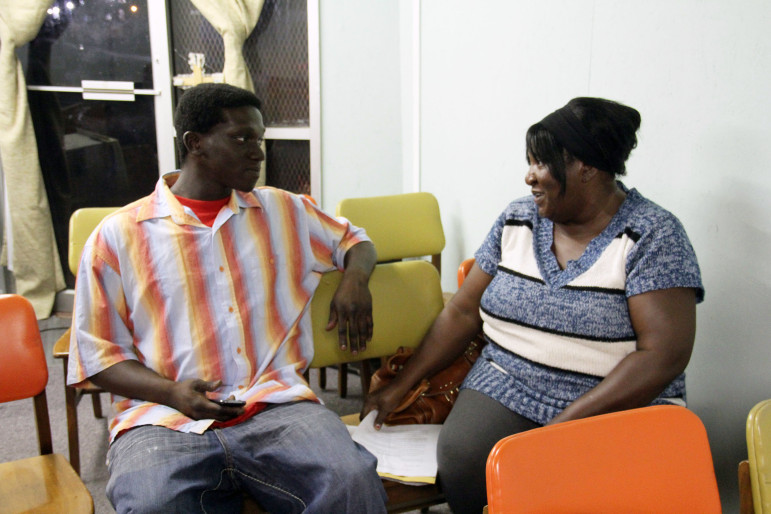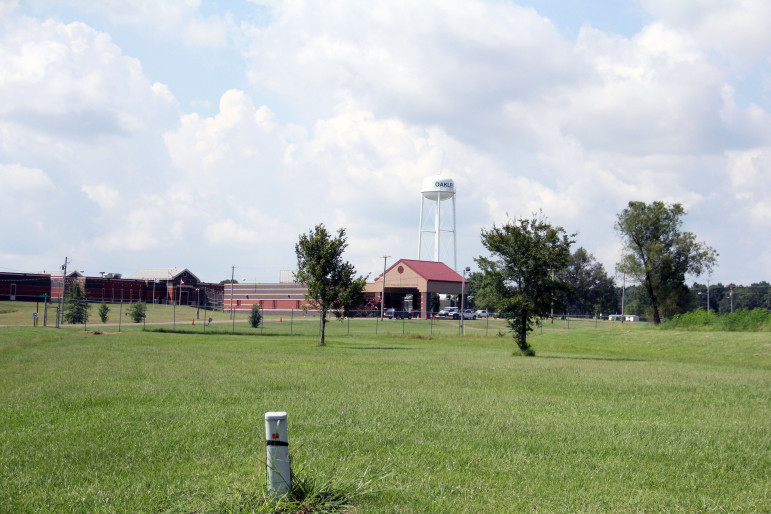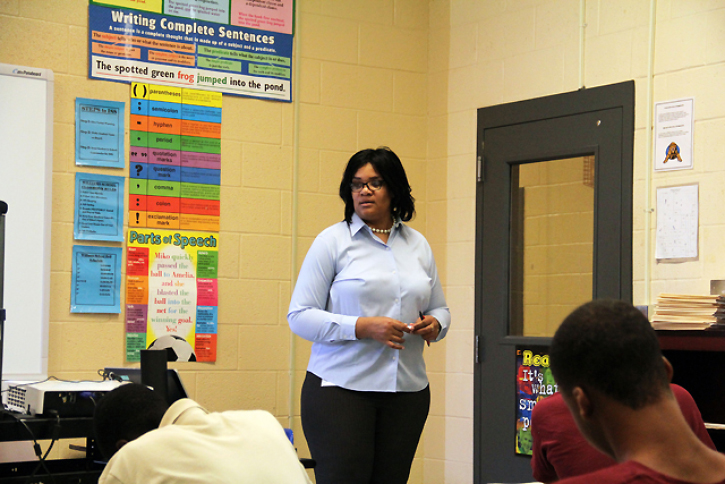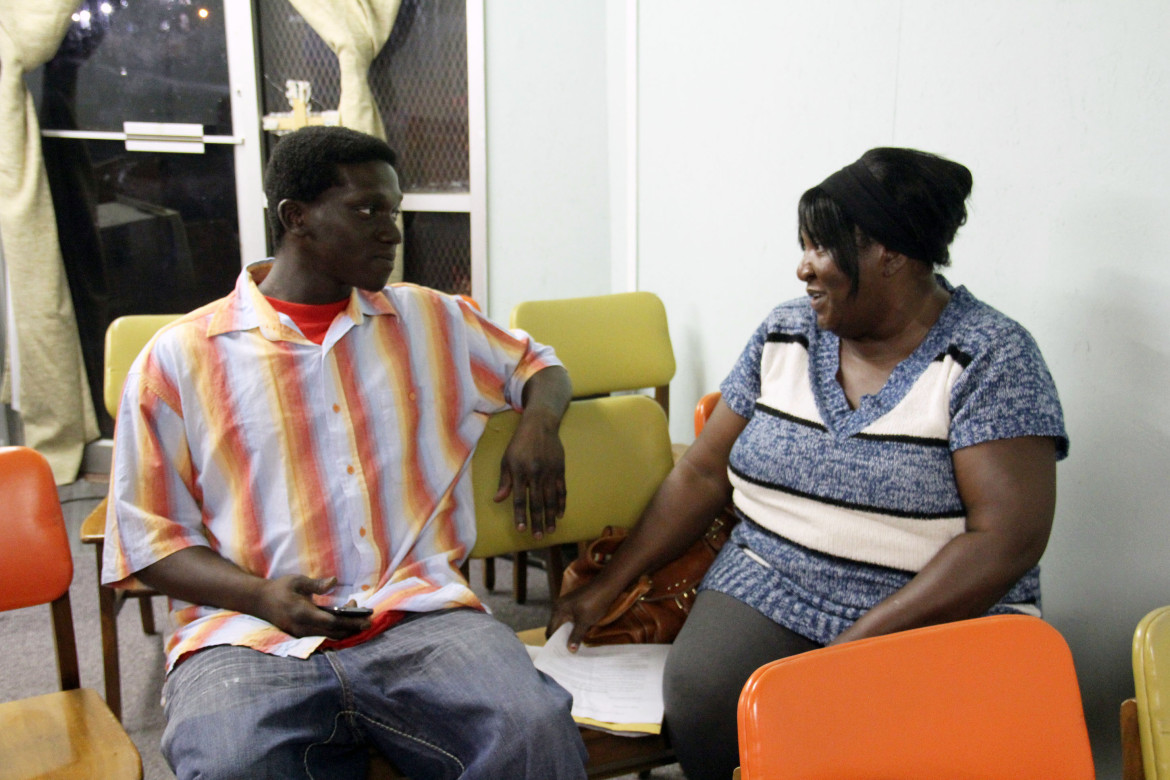This story was produced by The Hechinger Report, a nonprofit, independent news website focused on inequality and innovation in education, in partnership with the Juvenile Justice Information Exchange. Read more about efforts to improve education in Mississippi.

Toney Jennings couldn’t read or write when he was arrested at 16. Now 20 and still illiterate, he is dependent on his grandmother, Cornelia Glenn. (Photo by Jackie Mader)
CALEDONIA, Miss. — Toney Jennings was illiterate when he was arrested at age 16. In the six months he spent at the Lowndes County Jail in eastern Mississippi, he says he played basketball, watched TV and “basically just stayed to myself.”
A special education student, Jennings qualified for extra help in school. Those services should have carried over to the justice system, but Jennings said he never even attended class while in jail. Now 20, he is still unable to read or write.
Each year, thousands of Mississippi teens cycle through the justice system, where experts say the quality of education is often low. Incarcerated juveniles have the same educational rights as those outside — five hours of instruction a day that meet their learning needs, including special education. The state does not currently track how many of those juvenile offenders are entitled to extra education services, but according to a 2010 federal survey, 30 percent of youth in custody of the juvenile justice system have a diagnosed learning disability — six times the amount in the general population. Following several lawsuits, Mississippi has worked to improve the quality of education for all students in the system, with some successes.
Still, many of the kids who need help the most, like Toney, aren’t getting it, experts say. These students tend to already be academically behind, and encounters with the justice system early on only increase the likelihood that they’ll drop out of school or end up incarcerated as adults.
“Every day they’re not getting a real education, then that’s a day that we’ve lost,” said Sue Burrell, a staff attorney at the San Francisco-based Youth Law Center. “The kids that are in juvenile justice cannot afford to lose those days.”
Related stories: For special education students, diplomas, jobs increasingly elusive
Once arrested, male and female juveniles in Mississippi first go to detention centers to await trial. They can also be sentenced to these facilities for short periods of time. For longer stays — of several weeks or months — youth go to the Oakley Development Center, 30 minutes west of Jackson. All facilities are expected to provide classes on site with certified teachers.
The Mississippi Department of Education has budgeted $1 million in state funds per year for educating juveniles in 15 detention centers. In the 2011-12 school year, Mississippi spent an additional $844,000 in federal money educating more than 1,000 minors in juvenile and adult longer-term correctional facilities, according to federal data.
Although centers may monitor the number of special education students that pass through their doors, no state department has collected or analyzed that information. When reporters from The Hechinger Report asked the Mississippi Department of Education and the Office of Public Safety about the number of special education students in detention centers in the state, both agencies said that they believed the other entity was tracking those statistics. The Department of Education said it will track those numbers in the future.
To comply with the federal law that requires extra educational services for any student diagnosed with a disability, a school will create a legal document known as an Individual Education Program (IEP). This might include one-on-one time with a teacher or additional time to complete assignments. A student’s right to an IEP extends to juvenile justice and adult correctional facilities. But experts around the country say that the legally mandated services these students need are rarely provided once they enter the criminal justice system.
“Kids with special needs are not being served well,” said David Domenici, director of the Center for Educational Excellence in Alternative Settings. “My take is a lot of facilities don’t thoughtfully look at the IEP.”
Lawsuits bring change
Jennings, now 20, was raised by his grandmother, Cornelia Glenn, in Caledonia. She said he rarely got in trouble as a child. He loved fishing and dreamed of playing football professionally. He was diagnosed at age 8 with a learning disability and by the time he was in high school, he was placed in a classroom of only special education students for “behavioral issues” that weren’t part of his diagnosis, according to his IEP.
Aware of how far behind he was, Glenn agreed to send him to an alternative school that was recommended by school officials who said the smaller class sizes could help him academically.

The Oakley Youth Development Center holds youth convicted of crimes for up to 20 weeks. At any given time, a third of the students there will qualify for special education services. (Photo by Jackie Mader)
In 2010, Jennings was arrested on a charge of statutory rape. He was convicted as an adult and first sentenced to Lowndes County Jail. Lauderdale County Sheriff William Sollie, who oversees the jail, said it does not provide education to inmates because it’s a primary short-term holding facility. For the few who are sentenced to long-term stays, GED classes are offered. Jennings did not take them.
After several months at Lowndes, Jennings was sent to the Walnut Grove Youth Correctional Facility. At the time, the prison, a privately run facility an hour northeast of Jackson, was the only place for youths age 13 to 22 who had been tried as adults. Although the facility did have a school, a 2010 lawsuit by the Southern Poverty Law Center alleged that, among other things, fewer than half the 1,200 inmates there attended classes.
Jennings, who is currently out of prison on appeal, unemployed and living with his grandmother, said he took GED classes at Walnut Grove, but did not get the extra help he needed. Before going to prison, he read at a kindergartener’s level, according to his IEP. His math skills were that of a first-grader. But he’d been making progress at the alternative school, where teachers gave him more individual help.
“If he hadn’t gone to prison, I think he’d be reading by now,” Glenn said. “He would have learned more. [Now] he’ll always be dependent.”
As a result of the lawsuit, a new private company took control of the jail and Walnut Grove was converted into an adult facility. Current Walnut Grove warden Lepher Jenkins said he could not speak about the specifics of Jennings’ case because he was not in charge at the time. But he said Walnut Grove has always placed an emphasis on education and that any learning disabilities should be identified as soon as youth are admitted, and addressed in class.
Now that Walnut Grove serves adults, minors who are convicted as adults will go to the 2-year-old Youthful Offenders Unit at the Central Mississippi Correction Facility. The unit’s school, which was accredited in May, teaches all core subjects and offers vocational programs in lawn care, barbering and custodial services. The Mississippi Department of Corrections denied a request to visit the school.
The Walnut Grove lawsuit was one of many brought against Mississippi facilities. Legal action by the Southern Poverty Law Center and other groups about general conditions and abuse have also forced the closure of two detention centers, where teens go for shorter stays immediately after being arrested, and one youth development center, where those who are sentenced go for longer periods.
The one remaining juvenile correctional facility in the state only recently got out of legal trouble. In 2003, the Oakley Youth Development Center was sued by the U.S. Department of Justice for violating youths’ civil rights with “staff violence and abusive institutional practices, unreasonable use of isolation and restraints, and inadequate medical, mental health and educational services.” In 2005, Oakley entered into an agreement to carry out reforms. The facility’s school was accredited in 2012 and this fall, the lawsuit was dismissed.
Related stories: Can the hundreds of education experts who flocked to Mississippi improve life for the state’s black boys?
At first glance, Shirlinda Robinson’s second period English class at Oakley looks like a typical classroom, save for the guards who occasionally peer through the window. The room is decorated with posters detailing the parts of speech and giving tips on how to write a “satisfying paragraph.” On a Tuesday morning in September, Robinson walked her students, six high school-aged boys, through the standards they would be expected to meet during her next unit, like being able to analyze the theme of a passage. The students readily volunteered answers to questions and took notes.
Several students in Robinson’s class have IEPs. At Oakley at any given time, nearly a third of students qualify for special education. The majority of teachers are dual certified in special education, which makes it easier for them to directly address students’ needs. A special education coordinator keeps track of students’ IEPs and ensures they’re getting the services required, even if it means contracting with outside therapists or psychologists.
Robinson said for many of her students Oakley is the first time they’ve regularly attended school in years. Several students said they enjoyed the classes more than at their former school, and many also said they were learning more.
That was not true, however, of the detention centers where they stayed while awaiting sentencing. General and special education students at Oakley who were interviewed by The Hechinger Report said they learned little while in those facilities. One student said he was given easy worksheets. Another said his classes abruptly stopped when a teacher quit. He said it didn’t matter, though. His classes usually devolved into fights. Several students said they spent their school hours on computers, taking classes online but also surfing the web to play games or check fantasy football scores.
“It wasn’t really school,” one said.
A 2006 report found that education for all students at juvenile detention centers in Mississippi varied greatly. Two centers, in Jones and Lauderdale counties, provided no academic instruction, and one relied only on volunteer tutors. (The Lauderdale County center has since closed.) Just five out of 17 centers provided the legally required five hours of instruction per day with a certified teacher.
A subsequent law mandated that state-employed monitors (there are currently three) visit each detention center four times a year and make public reports about conditions at each center. According to those reports, education is now provided at all centers but one, and 12 of the 15 have a certified special education teacher. But even proponents of the original legislation say that the monitors’ reports have been superficial.
Donald Beard, head of the monitoring unit, said criticism of the reports is likely deserved, but that there are legal limits on what they can include. Complaints and other issues investigated by the monitoring unit are confidential. “I probably did not put a lot of effort into it,” he said. “Nobody ever read that stuff.”
Although the Department of Public Safety monitors the centers, school districts are directly responsible for providing education. Mississippi Department of Education spokesperson Jean Cook said the department supports the districts, adding that those “that don’t provide quality educational services are subject to sanctions.”
While teachers may have the right credentials to teach special education students, it doesn’t necessarily mean students are being taught well, said Jody Owens, director of the Southern Poverty Law Center. “What you continue to hear is that people are qualified special education teachers, but we just don’t feel the services are being provided,” he said. “You go into a classroom and you’ll see a computer that looks like it hasn’t been used or see students who tell you they play games all day.”
Related stories: Do ‘zero tolerance’ school discipline policies go too far?
In 2011, the Southern Poverty Law Center sued Jackson’s Henley-Young Detention Center, which can hold youths for up to 89 days. The suit, which alleged that youth were verbally abused by staff and regularly isolated in cells for up to 23 hours a day, came just two years after the monitoring unit called Henley-Young “a facility that can be a model for other centers not only in Mississippi but the entire Southeast.”
Following the suit, a federal judge appointed juvenile justice expert Leonard Dixon to make public recommendations on how to improve the center. Dixon has repeatedly called for an outside evaluation of the school, but it has not happened.
“The center doesn’t have the trained staff or money to adequately deal with mental health issues or teach special education students,” Dixon said. “They’re not prepared. That’s as plain as I can put it.”
Henley-Young did not return requests for comment.

Shirlinda Robinson, an English teacher at Oakley Youth Development Center, walks through new standards with her second period class. (Photo by Jackie Mader)
At Rankin County Juvenile Detention Center, which experts consider a model detention center, teachers make an effort to meet students’ individual education plans, which about half the youths have.
But it can be difficult. Teens continually cycle through the facility, and some stay just a week or two. An inmate’s previous school is supposed to send the student’s information and work immediately, but it can take several days, or longer, to collect documents from the more than 30 districts that send kids to Rankin County’s facility. And even then, the center often doesn’t have the same textbooks or workbooks, meaning students may fall behind peers in their regular school.
The center’s three teachers use an assessment that students take within 24 hours of arriving to tailor their lessons to their ability levels. Like Jennings, some might be on a kindergarten level, while others will be able to handle high school work. Teachers cater to the majority by teaching lessons at or close to a fifth-grade level, but also spending one-on-one time going over lessons sent from the students’ home schools.
“We get kids in every day. Every single day is different,” said Meggan Freeny, a special education teacher at Rankin. “We can’t guarantee that what we do in the classroom today is going to work tomorrow.”
Freeny works with the schools that the youth attended in order to access their IEPs and starts following them immediately at Rankin. For instance, if the plan requires a student to be in a regular classroom for 80 percent of the day, Freeny will pull them out and work with them individually the other 20 percent.
The center has also invested in nonacademic programs, like a reward-based behavior incentive program, where students can earn the right to work in the center’s greenhouse or a chance to play musical instruments. Every school day wraps up with an hour of character education. On a recent afternoon the girls’ classroom was writing “I am” poems, while the boys’ room discussed positive influences. One boy said that his mom “always taught him to do right” and that she was disappointed he’d been arrested.
“How are you going to fix that?” his teacher, Daniel Wilburn, asked.
“Don’t come back,” he answered.
“That’s the part of the day I look forward to the most is trying to mold these kids,” Wilburn said. “We’re not going to save them all but if we can save a few, it’s worth it.”


Pingback: Juvenile justice and special education needs